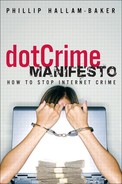Book Description
Internet crime keeps getting worse...but it doesn’t have to be that way. In this book, Internet security pioneer Phillip Hallam-Baker shows how we can make the Internet far friendlier for honest people–and far less friendly to criminals.
The dotCrime Manifesto begins with a revealing new look at the challenge of Internet crime–and a surprising look at today’s Internet criminals. You’ll discover why the Internet’s lack of accountability makes it so vulnerable, and how this can be fixed –technically, politically, and culturally.
Hallam-Baker introduces tactical, short-term measures for countering phishing, botnets, spam, and other forms of Internet crime. Even more important, he presents a comprehensive plan for implementing accountability-driven security infrastructure: a plan that draws on tools that are already available, and rapidly emerging standards and products. The result: a safer Internet that doesn’t sacrifice what people value most: power, ubiquity, simplicity, flexibility, or privacy.
Tactics and strategy: protecting Internet infrastructure from top to bottom
Building more secure transport, messaging, identities, networks, platforms, and more
Gaining safety without sacrificing the Internet’s unique power and value
Making the Internet safer for honest people without sacrificing ubiquity, simplicity, or privacy
Spam: draining the swamp, once and for all
Why spam contributes to virtually every form of Internet crime–and what we can do about it
Design for deployment: how to really make it happen
Defining security objectives, architecture, strategy, and design–and evangelizing them
How to Build a Safer, Better Internet
You’ll find yourself deeply concerned, then fascinated, then hopeful as you read about
• Building an Internet that resists online crime
• Phishing, botnets, and spam: tactical, workable, immediate countermeasures
• Establishing the “Accountable Web”: a strategic, long-term solution to Internet crime
• Improving security without sacrificing what people love about the Internet
The Internet is today’s Wild West: too much lawlessness, too little accountability. Now, one of the Internet’s leading pioneers shows how we can build a more trustworthy Internet: one that resists crime without frustrating honest people or compromising privacy and civil liberties. Drawing on years at the cutting edge of Internet and security research, Phillip Hallam-Baker offers a complete plan for reinventing the Internet: a plan that addresses everything from technology to politics and culture. Whether you’re a technology professional, policymaker, or citizen, this book will show you how we can make the Internet better, smarter, and above all, safer.
informit.com/aw
Preface xix
Acknowledgments xxiv
About the Author xxviii
Chapter 1: Motive 1
Chapter 2: Famous for Fifteen Minutes 37
Chapter 3: Learning from Mistakes 51
Chapter 4: Making Change Happen 81
Chapter 5: Design for Deployment 107
Chapter 6: Spam Whack-a-Mole 119
Chapter 7: Stopping Spam 135
Chapter 8: Stopping Phishing 155
Chapter 9: Stopping Botnets 175
Chapter 10: Cryptography 199
Chapter 11: Establishing Trust 215
Chapter 12: Secure Transport 227
Chapter 13: Secure Messaging 251
Chapter 14: Secure Identity 277
Chapter 15: Secure Names 311
Chapter 16: Secure Networks 323
Chapter 17: Secure Platforms 343
Chapter 18: Law 355
Chapter 19: The dotCrime Manifesto 377
Further Reading 383
References 387
Index 395
Table of Contents
- Copyright
- Preface
- Acknowledgments
- About the Author
- One. People Not Bits
- 1. Motive
- 2. Famous for Fifteen Minutes
- 3. Learning from Mistakes
- The Triumph of Slogans over Common Sense
- The World Is Waiting
- Security for Engineers
- Security Must Make Sense
- Political Priorities
- The End-to-End Principle
- Security through Obscurity
- Flawed Analogy
- False Reduction
- Is No Security Better Than Bad Security?
- Familiarity Leads to Complacency
- Failing to Recognize Success
- Key Points
- 4. Making Change Happen
- 5. Design for Deployment
- Two. Stopping the Cycle
- Three. Tools of the Trade
- Four. The Accountable Web
- 12. Secure Transport
- 13. Secure Messaging
- 14. Secure Identity
- 15. Secure Names
- 16. Secure Networks
- 17. Secure Platforms
- 18. Law
- 19. The dotCrime Manifesto
- Further Reading
- References
